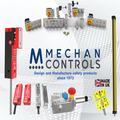
Posted to News on 3rd Aug 2024, 09:32
Contrinex provides spindle monitoring options for CNC machine manufacturer
When a CNC machine manufacturer was looking for a spindle monitoring solution to eliminate the risk of damage during tool change operations, it turned to Contrinex.

(See Plus Automation at FoodManufacturing.Live, 15 May 2025, on stand 49)
Contrinex, represented in the UK by Plus Automation, is renowned for the performance and reliability of its sensors. Still, another benefit is that the large size of its sensor portfolio can often give engineers a choice of sensor sizes, shapes, and sometimes different sensing technologies.
An example is a CNC machining centre, where three different sensing technologies could be offered to monitor the position of the machine's spindle collet's drawbar. The sensor must reliably confirm the drawbar's position to protect against damage from the tool being incorrectly engaged.
CNC machining centres are flexible because they can automatically change their cutting tools. The tool is held by a spring-loaded collet, actuated by a central drawbar that runs the length of the spindle. Once the tool to be changed is moved to its designated position in the machine's tool-storage magazine, an actuator pushes the drawbar forward to disengage the collet and release the tool. The spindle then moves to the location of the new tool in the magazine, and the process is reversed.
Occasionally, the collet may fail to retract fully, preventing the new tool from engaging thoroughly. Failing to detect and rectify the problem could cause expensive damage to the tool, the workpiece and possibly the spindle. Using Continex inductive sensors, three different solutions were offered to detect incomplete tool engagement in a tightly packed assembly robustly.
The three different inductive sensor technologies allowed the customer to choose what best suited its current and future machine designs.
Inductive sensor array
With inductive sensors as small as 3mm diameter, Contrinex is well placed to propose using an array of three inductive sensors to detect the position of a flange on the spindle's drawbar. Packaging and space constraints can also be addressed using cubic-bodied sensors, where detection is perpendicular to the sensor body rather than coaxial with a conventional cylindrical sensor.
Larger-sized inductive sensors, like the M8 sensors of the 500 Series', offer very low prices and are renowned for high performance and reliability, enabling low-cost solutions.
Contrinex's robust 700 Series' inductives can be used for demanding applications, with their 3x sensing range complementing their robust stainless-steel housing and the ability to survive impact, shock and abrasions. These robust sensors are available from as small as 4mm diameter.
Analogue inductive sensor
The precision of Contrinex's analogue inductive sensors can measure the distance to a longitudinally inclined face so that a PLC can interpret the spindle's position. As the drawbar moves forward, the distance to the slope of the inclined faces changes in direct proportion to the distance the drawbar moves. The sensor, which can measure to an accuracy of 2um, provides a precise measure of the spindle's position, in real-time, over its entire travel zone.
Despite their high precision, Contrinex's analogue inductive sensors are robust and are, for example, used to measure the long-term wear of seals in hostile environments.
SMART inductive sensor
Contrinex SMART sensors are available as Digital Measurement Sensors (DMS) or very high precision Analog Measurement Sensors (AMS). The digital version of the sensor is proposed for this application, measuring the distance to the inclined face at the end of the drawbar.
Whilst the sensor can provide a dynamic resolution of +/-5.5um across a sensing distance of up to 6mm via a 16-bit digital output, this application utilises the sensor's onboard microcontroller to present using two switched outputs, a 2-bit code, of four predetermined spindle positions.
IO-Link offers the PLC the ability to reconfigure the sensor's switching points, if required, for example, to allow different designs of spindle tooling. The customer also has the option of utilising the SMART sensor measurement data on subsequent machine designs.
Want the latest machine building news straight to your inbox? Become a MachineBuilding member for free today >>















